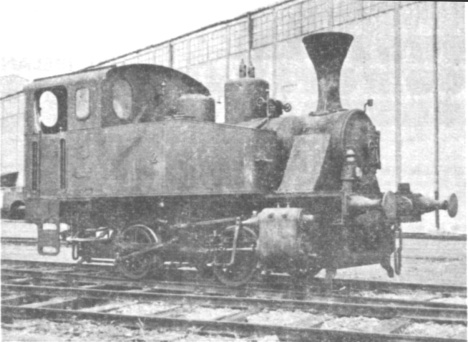
| THE INDUSTRIAL RAILWAY RECORD |
© DECEMBER 1965 |
|
INDUSTRIAL |
(3) IRELAND |
A good deal has been written recently on Irish industrial locomotives, firstly in "Some Industrial Railways of Ireland" by Walter McGrath (obtainable from the author at "Ferncliff", Bellevue Park, Cork, Eire, price 7/-) and more recently in the present writer’s "Irish Industrial and Contractors’ Locomotives" (published by Union Publications, 21 Delafield Road, London S.E.7, price 6/-). and in addition to which a nine page supplement is now available, price 3/-. A certain amount of additional material has since come to light, and it may be of interest to supplement the information in these two books, and in addition to discuss some doubtful points.
EGLINTON LIME COMPANY, GLENARME, CO. ANTRIM
Mr. J.H. McGuigan confirms that during the period 1916-1925 there was certainly a steam locomotive on this little line which ran from the quarry and works through a tunnel, across the coast road, and on to the harbour. Moreover, the gauge was 2' 6", not 2' 0".
BRUCKLESS
The 3' 0" gauge 0−4−0 saddle tank of this name (Hunslet 564 of 1892) began and ended its career in Ireland, and the details of its work in between are now known. Delivered to T.S. Dixon in May 1892 through the agency of Josiah Buggins as BRUCKLESS for the Donegal-Killybegs contract of the County Donegal Railways, it was sold in 1894 after the completion of the contract and later worked for the Preston Corporation Waterworks Department on the construction of the Spade Mill No.1 Reservoir at Longridge. There it was named SKYLARK. Subsequently, in 1907, it went, appropriately, to the Skye Marble Company and was used firstly by a contractor in building the Company’s railway from Torrin to Broadford, and then, from 1909, to work the railway itself. In 1913, following the failure of the quarries, the line was lifted and the locomotive sold to W.N. Jackson, a Glasgow metal merchant. He in turn sold it to J. Mackay, contractor for the Roundwood Reservoir in County Wicklow. This contract passed to H. & J. Martin Ltd. in 1915, and after its completion in 1925 the locomotive was scrapped. Thanks are due for these details to Dr Iain D.O. Frew.
(My own researches into Hunslet records add a little more to the story. During the period from July 1897 - the date from which the earliest detailed Hunslet spares records have survived - to March 1905 spares were sent to the Newcastle & Gateshead Waterworks. Delivery was sometimes to Otterburn, and the name of the locomotive was frequently quoted as BRUCKLESS. No name was quoted by Preston Corporation when ordering spares between March 1907 and March 1910.
November 1910 - W.R. Herring; name now quoted as DILWORTH.
January 1911 and May 1911 only - Skye Marble Ltd.; no name given.
August 1913 - named SKYLARK; spares ordered by W.H. Jackson, Glasgow, but sent to Mr. Easter, Skye Marble Cottages, Broadford, Isle of Skye.
May 1914 to May 1916 - John Mackay, Dublin Waterworks, Roundwood, Co. Wicklow.
The last spares of all were sent out in January 1921 to H. & J. Martin Ltd., Roundwood Reservoir. - K.P.P.)

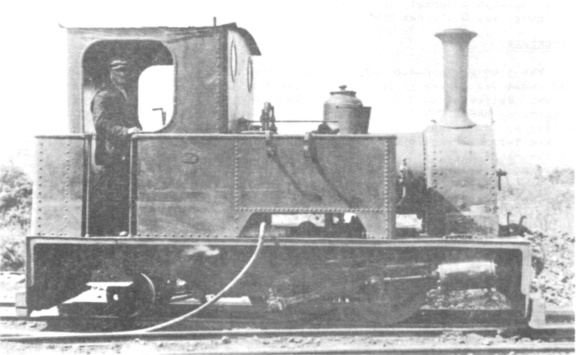
Upper - One of the few remaining steam locomotives in Ireland is Orenstein & Koppel 12476 of 1934, photographed at the Thurles sugar beet factory in July 1958. The following year it went to the Carlow factory, where it is now in use as a stationary boiler. (L.King)
Lower - The now defunct Kerr Stuart No.741 of 1900 at the Carnanee Quarry, near Portrush. (F.Jones)
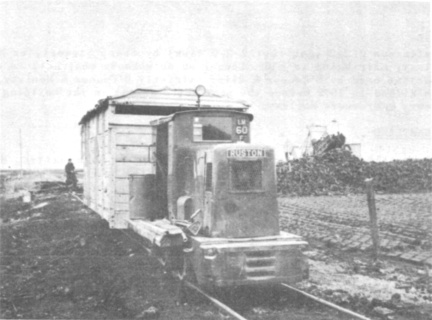
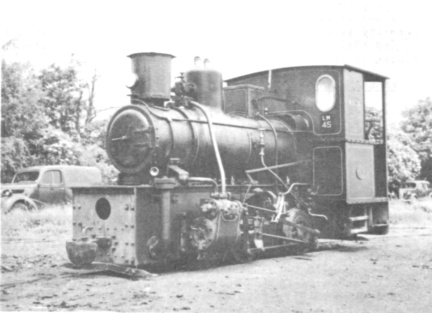
Two views of the extensive Bord na Mona system at Clonsast peat bog.
Upper - One of the many diesels (LM 60, Ruston Hornsby 259738 of 1948) on a special passenger train organised by the Locomotive Club of Great Britain.
Lower - One of the few steamers (LM 45, No.3, Andrew Barclay 2265 of 1949) outside the shed at Portarlington. L.King took the photographs, in July 1958.
CONNOR
The mysterious 2−2−2 tank (not 2−2−0 tank) by Sharp Stewart, ex Newry & Armagh Railway, attributed to a Mr. Connor on an unknown contract, is clearly the same as that used by O’Connor & Olley (strictly O’Connor & Manisty, Olley having been killed in 1872 before the contract started) on the building of the Dundalk, Newry & Greenore Railway.
ROWLAND & CARTLAND
A fearsome slip in the Union Publications book is in crediting Hunslet 611 to this firm. In fact, the name ERIN was carried by Hunslet 610, and 611 was ARGADEEN, a 2−6−0 tank of the Timoleague & Courtmacsherry Extension Light Railway.
R. WORTHINGTON
Research by Mr. R.N. Clements and Dr. J.D. Fitzgerald have shown that another engine was owned by R. Worthington was a narrow gauge 0−4−0 tank named ARMAGH. This was different to Hunslet 352, and they were known as the "Little Armagh" and the "Big Armagh" respectively. The little engine worked on the construction of the Castleblayney, Keady & Armagh Railway, which began in 1904, and about 1907 on the reclamation of a bog half−a−mile south of Keady. Later it worked at a quarry owned by the Great Northern Railway (Ireland) and when this closed, about 1911, it went to Goraghwood Quarry, whence it was removed to Dundalk in 1915. It is possible the engine was built by Orenstein & Koppel, but whence Worthington obtained it is a mystery. He may have purchased it new, but it is tempting to identify it with one of the two Orenstein & Koppel 0−4−0 well tanks (1193 of 1903, and 1517 of 1905) later used by Topham, Jones & Railton Ltd. at a quarry at Lyness in the Orkneys during the 1914-1918 War.
JOHN BIANCONI, LACKNASHANNAGH, CO. CLARE
It has been suggested that the "rail-lorry" which worked on this farm line was built by the "Lifu" company at Cowes in the Isle of Wight. This was a short lived firm specialising in paraffin-fired steam cars. It is thought also to have built some steam omnibuses which worked in London, but it is not known to have been active in railway work.
SIEMENS BAUUNION A.G., ARDNACRUSHA, CO. LIMERICK
It is somewhat difficult to trace the German engines imported by this firm in the makers’ lists as far as these are known. However, thanks largely to information supplied by Mr. G.S. Moore, there are certain possibilities that may usefully be noted. Hannoversche Maschinenbau A.G. numbers 9421 to 9426 and 9429 were 900 mm gauge 0−4−0 tanks for Siemens Bauunion A.G.; the difficulty is that the date is given as 1928. This would not be unlikely even though they immediately follow 9416 to 9420 of 1925, since at this period German manufacturers made a large number of engines for stock which may not have been sold for some years, and the dates bore the date of the eventual sale. On the other hand, 1928 may be a clerical error for 1925. Other such locomotives dated 1925, of which some conceivably might have gone to Ireland second-hand, were as follows:
| 9289-2929 | J. Moskopp, Bochum | |
| 9293 | Th. Lowald, Berlin | |
| 9294-9295 | R. Berndt, Dresden | |
| 9296 | J. Moskopp, Bochum | |
| 9297-9298 | Gewaerk Constantin D. Gr. | |
| 9309-9310 | Eisenbahn Material A.G. Stephenson, Berlin |
Linke Hoffmann A.G. built a number of 0−4−0 tanks for the 600 mm gauge in 1923: 2575-2586, 2669-2671, 2703, 2844-2850 and 2931-2934, but it has not proved possible to associate any of these with Siemens Bauunion A.G. (2680-2681 in fact may not have been built.)
It is supposed that the Jung 0−4−0 tank on the 600 mm gauge was a second-hand specimen out of the following list:
| 2936 | H. Elias & Co., Berlin | |
| 2938-2940 | Brenner & Co., Berlin | |
| 2941 | H. Elias & Co., Berlin | |
| 3172-3173 | Standt & Co., Berlin |
A photograph published in "The Railway Magazine" for May 1941, page 219, shows one of the Rheinische Metaalwaren engines bearing the SBU number 28. Five of these probably bore RMW numbers 1003-1007, and others may have been in the range 921-989.
ANTRIM IRON ORE COMPANY, CO. ANTRIM
Mr. J.H. Houston has suggested that there is some record of an 0−6−0 tank engine belonging to this firm being repaired by the Belfast & Northern Counties Railway. This may perhaps have been an engine of the Ballycastle, Cushendall and Redbay Railway with which the Antrim Iron Co. tramway connected, but further confirmation would be most welcome.
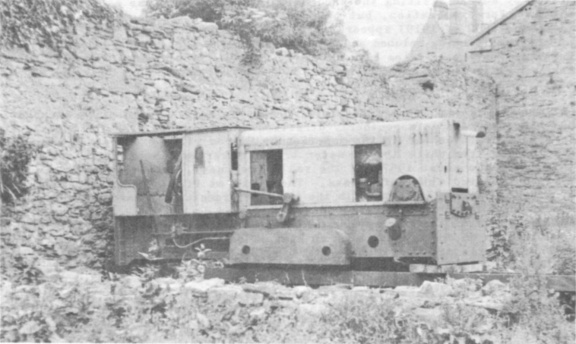
Electricity Supply Board, Ballyshannon. A view of Sentinel
9149 of 1934.
Photographed on 11th June 1948 by I.G.T.Duncan